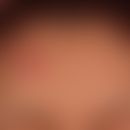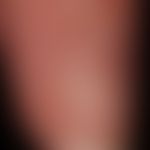Synonym(s)
HistoryThis section has been translated automatically.
Hyde, 1883
DefinitionThis section has been translated automatically.
Benign, mostly asymptomatic, skin-colored or slightly opalescent pseudocyst with gelatinous content. Frequently communicating with cleft digital interphalangeal joints and occasionally associated with osteoarthritis.
You might also be interested in
Occurrence/EpidemiologyThis section has been translated automatically.
Most frequent tumor of the fingers or toes. w>m.
EtiopathogenesisThis section has been translated automatically.
Trauma is considered the cause. A connection with mucoid degeneration of the connective tissue structures of the fingers or toes near the joints is also being discussed.
ManifestationThis section has been translated automatically.
40 to 60 years of age
LocalizationThis section has been translated automatically.
ClinicThis section has been translated automatically.
0.3-1.5 cm large, rough, predominantly painless, only occasionally painful, translucent, light grey bulges of the proximal nail fold. Often spontaneous rupture. A glassy, gelatinous liquid is discharged. If localized under the nail matrix mostly reddened lunula. In the case of prolonged dorsal cysts a longitudinal, channel-shaped nail dystrophy develops.
HistologyThis section has been translated automatically.
Flat extended epidermal band. Pseudocyst (no epithelial lining) usually in the upper dermis. This contains mucin rich in hyaluronic acid, which stains with alcian blue. Frequently fibrosed connective tissue in the immediate vicinity of the cyst lumen. Inflammatory infiltrates are absent.
Differential diagnosisThis section has been translated automatically.
Myxoid degenerated fibrohistiocytic tumors. In the rarely occurring verrucous surface of mucoid dorsal cysts, vulgar warts must also be differentiated in the differential diagnosis, whereby the diagnosis can only be made histopathologically in this case
TherapyThis section has been translated automatically.
Try compression therapy for several weeks (may be successful).
Another option is aspiration, or incision and expression of the cyst contents, and intracystic application of a glucocorticoid crystal suspension (e.g. 40 mg triamcinolone). Subsequently, compression bandages are applied for several weeks.
Operative therapieThis section has been translated automatically.
In case of failure of conservative therapy approaches: Complete extirpation in toto under block anaesthesia and under tourniquet. Postoperative immobilization with plaster splint for 10 days.
Cave! Risk of injury to the nail root! The patient must be urgently informed that this complication may occur (consequence: longitudinal nail dystrophy or splitting of the nail!)
Progression/forecastThis section has been translated automatically.
LiteratureThis section has been translated automatically.
- de Berker D, Lawrence C (2001) Ganglion of the distal interphalangeal joint (myxoid cyst): therapy by identification and repair of the leak of joint fluid. Arch Dermatol 137: 607-610
- Hernandez-Lugo AM (1999) Digital mucoid cyst: the ganglion type. Int J Dermatol 38: 533-535
- Marzano AV et al (1997) Unique digital skin lesions associated with systemic sclerosis. Br J Dermatol 136: 598-600
Salerni G et al (2014) Dermatoscopic pattern of digital mucous cyst: report of three cases. Dermatol Pract Concept 4: 65-67
- Schmoeckel C et al (2000) Dorsal mucoid cyst--ganglion-like pseudocyst of the joint space. dermatologist 51:682-684
Incoming links (16)
Cyst; Cyst, mucoid digital; Digital mucoid cysts; Digital mucous cyst; Dorsal cyst mucoid of the finger; Finger cyst, mucoid; Ganglion; Mucoid dorsal cyst of the fingers; Mucoid finger cysts; Myxomtosis nodularis cutanea; ... Show allOutgoing links (1)
Triamcinolone acetonide;Disclaimer
Please ask your physician for a reliable diagnosis. This website is only meant as a reference.













